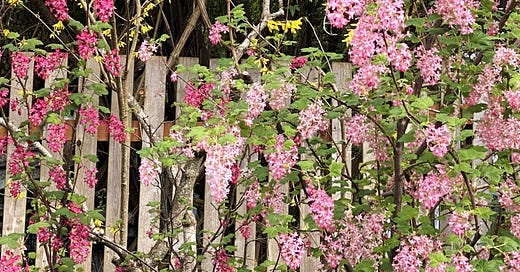Footnotes to a Conversation, April 7, 2025
Life is not a matter of holding good cards, but of playing a poor hand well.” – Robert Louis Stevenson
Pink Is for Girls
Except that didn’t used to be the case. In the late 19th and early 20th centuries, boys were dressed in pink and girls in blue. Pink, faded red, was seen as the stronger colour, hence more befitting boys. The word pink first appeared in the Oxford English Dictionary in the late 17th century and was probably named after a flower, Dianthus plumarius, also know as the pink. Madame de Pompadour helped popularise bright pink Sèvres porcelain, while Marilyn Monroe helped make shocking pink “the colour of choice for twentieth-century women who wanted to be both seen and heard.” [The Secret Lives of Colour, Kassia St. Clair]
Master Carpenters
“In Japan we have a deep respect for our forests … If a carpenter uses a 1,000-year-old tree, they must be prepared to take on more than 1,000 years of responsibility for the building that they create.”
An exhibit of Japanese carpentry in London, UK, demonstrates just how much care went into building a Japanese temple. For example, more than 50 handcrafted wooden pieces go into assembling just one of the brackets holding up the roof. “It may seem like a decorative flight of fancy, a bravura exercise in complex carpentry, simply to embellish the corners of the temple, but these brackets serve a crucial seismic purpose too. ‘We have a lot of earthquakes in Japan,’ says Nishiyama. ‘The reason these temples have survived so long is because of these intricate timber joints, which allow the structural members to slide past each other, as well as distributing the load.” [The Guardian]
The Gentle Art of Untravelling
In Journeys to the Nearby; The Gentle Art of Untravelling, Elspeth Bradbury slows down and explores her Horseshoe Bay garden, standing motionless while a hummingbird feeds, tasting a magnolia petal, and sending a maple helicopter twirling through the air.
“To make our way in peace among such humble gifts as a wren’s song, a butterfly, a passing kindness or a smile exchanged, isn’t that how most of us would ultimately choose to spend and end our days? … This iris, small as it seems, is by no means inconsequential.” [Ronsdale Press]
Running Horses
I admire Joe Fafard’s sculptures so was interested to read an article about Running Horses on display in front of the National Gallery in Ottawa where it is available for all to see free of charge. When asked about the important characteristic of his art, Fafard said it was accessibility, allowing people from all walks of life to experience his work. [National Gallery of Canada]
The Common Good
I’ve just finished reading At a Loss for Words: Conversations in an Age of Rage by Carol Off. I have a much better understanding now of what far-right parties around the world hope to achieve, and it runs counter to everything I was brought up to believe in by a father who was, I expect, the first in his family to obtain a university degree and a mother who lived her Christian beliefs by helping other people.
Carol Off says, “The Canadian system of redistributed wealth for the common good made sense to my father, based on his life experience, and it makes sense to me … It’s about reconstructing a government that takes care of its people (even those who fail to vote for it) and a political system that’s transparent … Oliver Wendell Holmes Jr. said it best: taxes are the price we pay for civilization.” [Carol Off]
Footnotes to a Conversation is a weekly Monday feature covering an assortment of topics that I’ve come across in the preceding week – books, art, travel, food, and whatever else strikes my fancy. I also post occasional articles on other dates, including frequent book reviews and travel tales.
If you share my love of nature, check out EcoFriendly West, an online publication encouraging environmental initiatives in Western Canada, and Nature Companion, a free nature app for Canada’s four western provinces.




